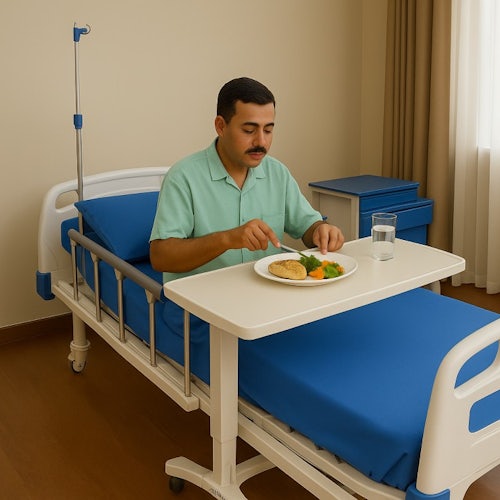Advantages of Hospital Beds in Home
Advantages of Hospital Beds

1. Improved Patient Comfort and Positioning
One of the primary advantages of hospital beds is their ability to adjust in multiple ways—head, foot, and overall height can be controlled to suit the patient’s comfort and medical needs. This helps reduce discomfort, improve circulation, and support better breathing. Adjustable beds are especially important for patients recovering from surgery, those with mobility challenges, or individuals confined to bed for long periods.
2. Enhanced Safety Features
Hospital beds are designed with built-in safety features such as side rails, lockable wheels, and emergency CPR functions. Side rails prevent patients from accidentally falling out of bed, particularly at night or during movements. This is especially helpful for elderly or disoriented patients. Many modern ICU beds also have sensors that alert caregivers when a patient attempts to get up.
3. Ease of Care for Healthcare Providers
For nurses and caregivers, hospital beds significantly reduce the physical strain of patient handling. Height-adjustable beds allow for easier patient transfers and safer posture for the caregiver. Functions such as Trendelenburg (tilt) positions or one-touch operation make tasks like wound care, feeding, and hygiene management more efficient.
4. Infection Control and Hygiene
Most hospital beds are built with materials that are easy to clean and disinfect. Surfaces are designed to be non-porous and resistant to bacteria and bodily fluids, which supports infection control protocols. This is essential in clinical environments where hygiene is paramount.
5. Advanced Monitoring and Integration
High-end hospital beds—especially in ICUs—come with integrated systems that monitor vital signs, track patient movement, and provide digital interfaces for caregivers. These smart beds can be connected to electronic medical record systems (EMRs), improving data collection and response times in emergencies.
6. Mobility and Portability
Hospital beds are designed to be mobile. Their wheels and brakes enable easy movement from one ward to another or repositioning within a room. This mobility is crucial during emergencies or when patients need to be transferred for tests or procedures.
Conclusion
Hospital beds play an essential role in improving patient care and supporting healthcare providers. Their adjustability, safety features, and technological integration offer significant advantages, particularly in clinical or long-term care settings. However, these benefits come with challenges such as cost, maintenance, and spatial requirements.
Selecting the right model that suits the patient's condition, caregiver's needs, can make a substantial difference in the quality of care and recovery outcomes.
If you wish to know more about KRAFT Hospital beds please contact us +91 7358062727 (Available at Whatsapp also)
































